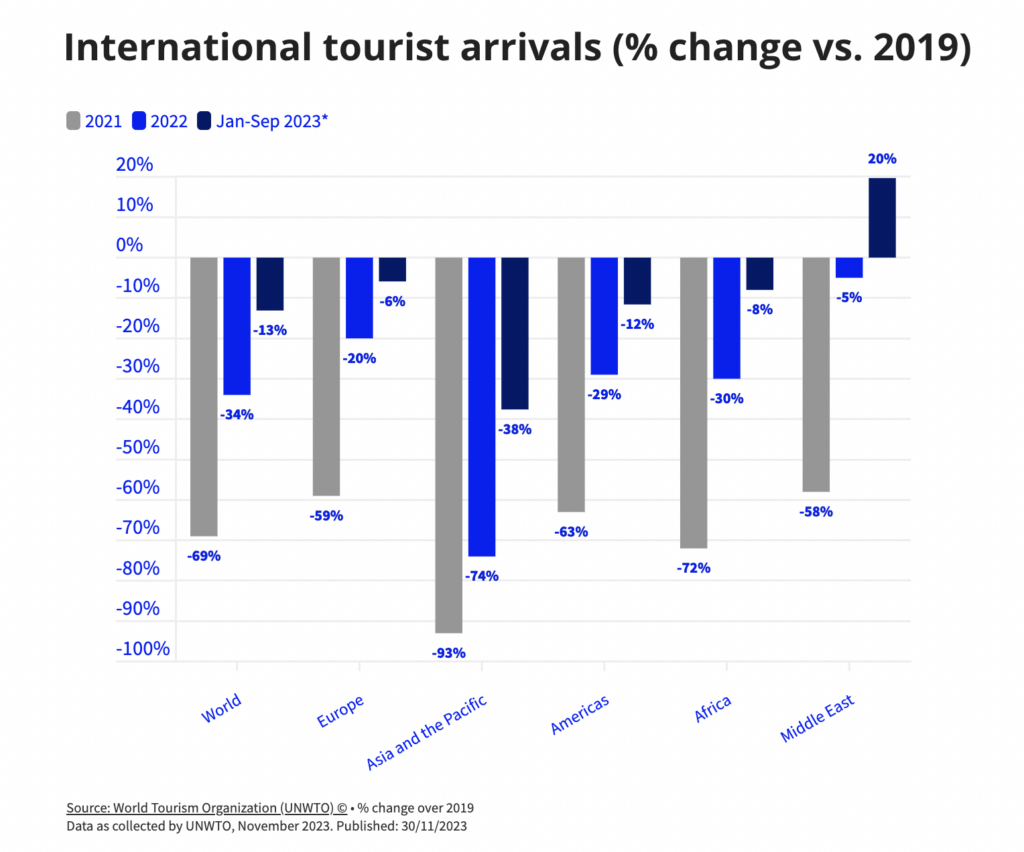
An introductory statement before delving into Tourism Marketing.
“International tourism is on track to recover almost 90% of pre-pandemic levels by the end of this year”, so to the latest data from the World Tourism Organization (UNWTO), “an estimated 975 million tourists travelled internationally between January and September 2023, an increase of 38% on the same months of 2022.”

Source: UNWTO
Why does all of this matter in the realm of Tourism Marketing? Well, as demand increases, the supply needs to be prepared to meet it. While there are various strategies to boost sales, investing in content creation stands out as a cost-effective approach that yields lasting value.
Now, the question arises: how do you craft content that drives sales? When venturing into content creation for your website, remember some of the key principles.
Tourism marketing key principles for content creation
Conversational Tone
The challenge when creating website content is to project professionalism without coming off as condescending or overly formal. How do you determine if content is conversational? It should feel like a dialogue between you and the reader—a continuous exchange where your target audience not only sees your content but also responds to it.
The power of conversational content lies in weaving real stories from your target market into your existing content, adding validity to your message. Social proof, derived from reviews or social media, further bolsters the initial claims you make about your product or service.
The art of storytelling
Now, let’s talk about the art of storytelling.
People are drawn to stories. Even if you have an outstanding product, service, and team, the inability to narrate a compelling story about your company can result in losing readers.
As a company or individual addressing the problems of others, your narrative should resonate with readers, specifically addressing the challenges they face. While asserting that the experience you offer can transform the lives of travelers may seem ambitious, framing it as a solution for a stress-free family trip with young children or a secure solo tour for an individual can fulfill a crucial need for your customer. This connection can be established through storytelling. It’s common for website content to immediately delve into how a product or service has the potential to revolutionize the customer’s life. However, a well-crafted story can ignite the reader’s desire to achieve the ultimate result your product or service provides. While storytelling is not a new concept, it is often underestimated and overlooked!
Common content creation pitfalls to steer clear of
- Ineffective or nonexistent content can leave visitors on your site without clear guidance.
- If your content overly centers on your company and lacks relevant answers to your target customers’ questions, it might miss the mark.
- Additionally, using inappropriate terminology to convey your company’s size can hinder communication. For instance, if you’re a team of 17 people, it’s acceptable to use “we,” but if you’re a tour guide, opting for the first person, using “I,” can help prevent communication barriers.
- Furthermore, creating overly lengthy content can be counterproductive. It’s crucial to keep it concise and get to the point without unnecessary elaboration. Too many words might overwhelm readers or give the impression of talking down to them.
- While professional website design is essential, it’s equally important to complement it with well-crafted text. Don’t assume that content creation is a straightforward task; entrusting it to someone lacking experience in writing or the digital marketing field may lead to subpar results.
- Moreover, it’s easy to overlook the delicate relationship and balance between design and content. The synergy between the two is crucial for an effective website.
- Finally, generic content that fails to distinguish itself from competitors’ offerings can render your efforts ineffective. Crafting unique and engaging content is key to standing out and capturing your audience’s attention.
What are the steps of Content Creation for Tourism Marketing
Web Content Creation – lay the groundwork!
Idea generation: before typing a single word, a good deal of reflection is needed. Don’t start writing until you have thought about who you are as a company, where you position yourself in the market, the desires and needs of your customers, and your current gaps.
Find Your USP: even in a saturated market, there is always a way to differentiate yourself from your competitor. Consider your guides, your destination, reviews, safety standards, sustainable practices, customer service, an easy booking system, or the value you offer to your customers. Find something that sets you apart and highlight it.
Listen to your customers: if you are an established company, the requests you receive are vital to understanding your tours and your customers. The fewer requests you receive, the more efficient your website is. If requests come consistently, consider including an FAQ section on the tour page to address questions and concerns before the customer has to look elsewhere.
Customer research: your image influences the type of customers you attract, but those who book truly reflect your company. Once you have a good understanding of who you are trying to reach, it will be easier to write content that is suitable.
Spy on competitors: keep an eye on what your competitors are doing, the type of content they publish (images, videos, blogs, articles). What tone do they adopt? How do they address customers? You can learn a lot by staying tuned to the target market. Study their strategy, and if useful, try to take inspiration.
SEO research: a quick Google suggest search can reveal your main themes and competitors. If they are at the top of the list, they have definitely done something right! Pay attention to keywords in their tour titles and descriptions before conducting a detailed keyword analysis.
Content Marketing for Tourism – Content Writing!
Prioritize clarity: the number one rule for website content. No one wants to deal with complicated texts. The purpose of a tour operator’s website is to convey essential information about the tour/experience. Your prices are what they are for a reason; treasure them and allow the user to find this information quickly.
Showcase your brand: it’s time to spread the message about who you are. Highlight your brand in the content: WHO you are, WHERE you are located, WHAT you do, WHY you do it, and HOW you do it. If you have to book an experience in a place where you are on vacation, you want to clearly understand the company and what it offers. Customers need to be convinced of your credibility.
Speak to your target audience: are you a luxury tour operator, or do you offer a budget experience? Your content should address the customers you want to attract or your current customer base. Understand exactly who can benefit from your experience and speak to their needs. Be honest about what they can expect!
Address pain points: this is where customer research comes into play. Use questions received from potential customers to address their hesitations and fears. Establish credibility and reduce anxiety. Adventure-based businesses should emphasize the level of safety. Established companies can mention the founding date or awards. Small tour operators can highlight being family-run.
Compare your tours: it’s not only important to differentiate your company in the market but also to distinguish between the experiences offered so as not to create confusion in your customer’s mind. Each of your tours should have a unique USP; including key details at the top of each tour page to outline specific experiences is a way to help visitors decide which tour is right for them and encourage booking.
Emphasize the experience: use sensory words. Evoke the images, sounds, and smells your guests will experience. While it’s necessary to include essential details clearly and concisely, don’t be afraid to play with the content, always using a conversational tone. Break up the content with maps, images, and videos to bring your site to life.
Integrate videos: videos can showcase your brand’s personality to differentiate yourself from competitors and allow viewers to get an idea of the experiences offered by seeing them in action. Video content has proven to be significantly more memorable than text or images.
Celebrate your successes: reviews, media mentions, partnerships: share your successes with your customers! There is a difference between establishing credibility and boasting; don’t say it yourself, show visitors (through reliable third parties) the value.
It’s up to you to stand out in the eyes of potential clients through your content! In case you feel you lack the necessary skills to handle this challenge independently, we are here to offer our support. Contact us today, and we would be delighted to introduce you to our specially designed Website Builder plan, crafted to collaborate with you in the context of Content Marketing for Tourism.
Read some case studies:
- Content marketing from scratch: Adventoured
- Outdoor travel marketing: Itinera Bike & Travel
- Historical SEO: YouLocalRome

